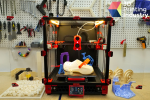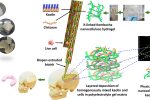3dprintingindustry.com
3D Printing Industry reviews the Voron 2.4-300 RevD.In collaboration with open-source 3D printer kit designer Voron Design, Shenzhen-based LDO Motors offers a lineup of DIY CoreXY 3D printers. These include the Voron 0, Voron 2.4, Trident, and Switchwire.This article reviews the Voron 2.4-300 RevD, the latest version of LDOs flagship Voron offering. Boasting impressive stability and accuracy, the assemble-at-home 3D printer is tailored to professionals and hobbyists seeking a configurable, high-speed production system.With prices starting at $1,299.00, the kit includes all of the required structural and electrical hardware and the LDO specific 3D printed parts. The remainder of the Voron standard printed parts need to be sourced and/or printed by the user. We 3D printed these ABS components in under 200 hours.Users considering a foray into the world of DIY 3D printer construction should be aware that building the Voron 2.4 is not straightforward. We wouldnt recommend this for newcomers, the 263-page manual is better suited to those with more experience and technical knowledge looking to build a high-performance machine.However, building, programming, and calibrating the 3D printer from scratch is an incredibly rewarding experience. This is a long-term project, a key part of the kits appeal. Makers will come away with a better understanding of how 3D printers function, allowing them to customize the system for their needs and preferences.The LDO Voron 2.4-300 RevD 3D printer. Photo by 3D Printing Industry.Why choose the Voron 2.4?LDOs Voron 2.4-300 RevD combines advanced 3D printing features into an affordable, desktop-sized package.Build volume options range between 250, 300, and 350 mm for the X, Y, and Z axes. The single-extruder CoreXY FFF 3D printer also offers compatibility with a wide range of high-performance materials, including ABS, ASA, PETG, CPE, Nylon, TPU, and TPE. This makes it well-suited for those wanting to produce functional prototypes and end-use parts with engineering-grade properties.A key draw of the Voron 2.4 over other open-source 3D printer projects is the inclusion of high-quality, premium hardware sourced by LDO. A large 4.3 touchscreen, Bondtech extruder parts, LDO Leviathan controller, Raspberry Pi, and two E3D Revo high-flow brass nozzles are included in the kit. The latter includes 0.6 mm and 0.4 mm diameters, which both performed reliably with minimal clogging, even when extruding hygroscopic materials prone to blockages. A Nitehawk SB tool board is also included for the Voron Stealthburner tool head, which offers compatibility with virtually all commercial hotends.The Voron 2.4s tool head and printhead assembly. Photos by 3D Printing Industry.High-speed 3D printing is another key selling point. The system boasts 25,000 mm/s tool head acceleration and a 500 mm/s maximum printing speed. While reliable parts can be produced at these rates, they will require precise machine configuration and tuning. Therefore, we found 300 mm/s to provide the best balance between 3D print speed and acceleration.The robust metal frame ensures LDO and Vorons DIY 3D printer remains stable at these speeds, while stainless steel linear rails further support fast printhead movements. The system is advertised as offering impressive accuracy, repeatability, and print quality, claims we have assessed through several stringent benchmarking and application tests.The Voron 2.4 also uses four independent motors, offering extensive print bed adjustment capabilities. Automatic bed leveling is enabled by an inductive probe, which measures four points on the print bed three times. Using the average of these readings, the system automatically adjusts each motor, ensuring the bed is always optimized for a successful first layer.The LDO Voron 2.4s key hardware boxes and assembled architecture. Photos by 3D Printing Industry.Building the LDO Voron 2.4LDOs Voron 2.4 targets makers and tinkerers who enjoy configuring, optimizing, and personalizing their tech. Therefore, a major part of its appeal lies in the building process. Plenty of other companies offer high-quality 3D printing straight out of the box. The 3D printer kit, however, is a great choice for those seeking a more hands-on approach. As an open-source project, Voron supports the integration of third-party hardware and softwareoptions that arent available with most pre-assembled systems, offering greater flexibility.Assembling the Voron 2.4 was a long and challenging process. It took approximately 50 hours to complete the kit construction and programming steps. Those with little or no knowledge of 3D printers and electronics will likely struggle, as multiple stages require familiarity with mechanical and electrical components. LDO has a channel with a support team on the Voron Discord server as well as a very active community of volunteers to help answer build questions.LDO Voron 2.4 3D printed parts. Photos by 3D Printing Industry. Programming the 3D printers firmware involved adding pre-written scripts to its configuration files, which was relatively straightforward. However, identifying and resolving missing elements required frequent trial and error, creating a steep learning curve. Fortunately, the active and supportive Voron Discord community proved to be an invaluable resource here. Support teams often responded to our queries in just 10 to 15 minutes.The build process was further aided by LDOs addition of pre-cut and crimped wires, which allowed for simple plug-and-play installation. However, a steady hand is needed for the soldering operations, which could frustrate less experienced makers.Key components and electronics of the Voron 2.4. Photos by 3D Printing Industry. Voron 2.4 benchmarking testsOnce built, how does the Voron 2.4 stack up against other desktop FFF 3D printers? To find out, we conducted a range of benchmarking prints. The first, a test cube included with the 3D printer, sought to identify and correct performance inconsistencies. This served as a quality control measure before conducting application-specific or accuracy-critical prints.Our first 3D print on the Voron 2.4 was somewhat disappointing. The cube featured a disrupted first layer and noticeable layer lines caused by rapid changes in the nozzles direction.To fix this, we integrated the Klipper Adaptive Meshing & Purging (KAMP) configurations and macros, as well as re-tensioning the drive belts on all axes. While KAMP contains four configurations, we only activated the purging line option, which purges filament near the print area, rather than along the side of the bed.This resulted in a much improved second attempt, completely eliminating surface gaps. After additional tuning, including updating the PA, EM, and Input shaper settings, the third test cube featured a smooth first layer and improved surface finish.The first, second, and third 3D printed test cubes. Photos by 3D Printing Industry.When 3D printing batches of identical parts, repeatability is essential. To assess how the LDO Voron 2.4 handles repeatability, our team 3D printed square, hexagon, and tube models 12 times each. These were then measured and compared against their intended dimensions. Adept 3D printers will generally achieve an average deviation under 0.1 mm, and a standard deviation below 0.05 mm.3D printed repeatability test parts. Photos by 3D Printing Industry. The Voron 2.4 performed well here. The mean difference for all parts came to 0.0974 mm, while the collective standard deviation came to 0.0357 mm, easily within the 0.05 mm maximum limit. Both the square and hexagon parts demonstrated impressive results, showcasing the 3D printers value for batch production. Dimensional inaccuracies were noted for the tube parts. However, both ratings were within the expected limits, showcasing the Voron 2.4s high precision.Difference between the measurement and reference for the square (first), hexagon (second), and tube (third) parts. Images by 3D Printing Industry.How well does the Voron 2.4 handle circular parts? To evaluate this, we 3D printed several models with circular sections measuring 100 mm, 65 mm, and 20 mm in diameter. Unfortunately, the printer struggled, with both the mean dimensional error and standard deviation exceeding ideal limits of 0.1 mm and 0.05 mm. Our tests collectively achieved a mean difference of 0.2083 mm and a standard deviation of 0.0635 mm, disappointing results reflecting poor consistency and accuracy in the X and Y axes.This below-par performance was exacerbated by the 3D printers asymmetric belt tension setup. Additionally, the gcode files structureusing triangular surfaces to approximate curved shapesintroduced jagged edges, further reducing the precision of the 3D printed circles.Circular trajectory 3D printed models. Photos by 3D Printing Industry.Parts with more complex geometries often include overhanging features that arent reinforced by support structures. We tasked the DIY 3D printer with fabricating test parts featuring 6 overhangs each, increasing by five degrees from 40 to 65.The results were quite impressive. Strong consistency was achieved across both axes up to the 65 angle. At this point, the surface quality of the part deteriorated due to insufficient cooling, which caused warping and layer inconsistencies. Reducing the 3D print speed could mitigate this issue by allowing more time for layer cooling and solidification. The standard overhang limit for most FFF printers is around 55, with the Voron 2.4 clearly exceeding typical overhang performance.3D printed overhang tests. Photos by 3D Printing Industry.To further assess the Voron 2.4s ability to achieve support-free 3D printing, we conducted a bridging test. This is another good evaluation of the 3D printers cooling ability, with faster cooling resulting in a better surface finish on the underside of the bridges.Although shorter bridges showed minimal sagging, the longer sections did not fare as well, possessing clear drooping and uneven formation. While the standard bridging limit among FFF systems is 20 mm, LDOs offering demonstrated good performance until the 60 mm mark. As such, the DIY kit once again outperformed many of its pre-assembled counterparts.3D printed bridge test parts. Photo by 3D Printing Industry.Our Voron 2.4s advertised build volume was 300 x 300 x 300 mm. Unfortunately, our testing found the systems Z-axis limit is unreachable. By default, the printers configuration file limits this height to 270 mm, 10% less than advertised, due to the hotend configuration. On a more positive note, our 3D printed 270 mm-tall tower exhibited excellent layer stacking and consistency without visual defects.3D printed tower test. Photos by 3D Printing Industry. Unlike the Z axis, our perimeter test confirmed that 3D printed parts can utilize the entire 300 x 300 mm X and Y axes. The part came out well, free of defects. Heated build beds often experience temperature variations at the corners, causing warping. However, the Voron 2.4s bed maintained a consistent temperature, resulting in a successful test.3D printed perimeter test. Photos by 3D Printing Industry.We next conducted our in-house 3DPI test, which provides a comprehensive view of the 3D printers ability to handle intricate geometries and common challenges. The Voron 2.4 achieved an impressive score of 87.41/100, which exceeds many competing products in the FFF 3D printer market.3DPI benchmark 3D printed model. Photos by 3D Printing IndustryA week of fine-tuning hardware, firmware, and slicer settings allowed us to achieve this result, reflecting a key benefit of the 3D printers adjustable, open-source architecture. Clean overhangs were achieved until the 70 point, while the bridging test showed uniformity and consistency until the 50 mm length. Some defects were noted with stringing, cornering, and internal features. However, these were minor footnotes in an otherwise admirable display.3DPI test radar chart. Image by 3D Printing Industry.Our team also assessed the Voron 2.4s ability to 3D print a nut and bold part with tight tolerances and functional thread. This test piece was fabricated to a high standard, showcasing excellent detail and functionality. Its impressive detail and surface finish confirmed the DIY 3D printers ability to accurately fabricate small and precise parts.Small and precise parts test. Photos by 3D Printing Industry.Testing 3D printing applicationsThe creation of functional parts is a common use case among desktop 3D printer users. To evaluate the Voron 2.4s capability in this area, we fabricated a multi-part soft claw grip. The design included a gauntlet, claw side, hand support, tendon, and tri-claw, along with 14 bolts and 10 nuts.Our self-assembled 3D printer performed exceptionally well with the larger components, producing them with excellent precision. The smaller parts also met the required tolerances, and all sections fit together seamlessly, enabling flawless functionality of the claw grip. We were particularly impressed by the 3D-printed bolts and nuts, which securely held all the parts together, resulting in what we believe will be a durable and long-lasting device.3D printed soft claw grip. Photos by 3D Printing Industry. Prospective customers may also wish to 3D print functional end-use parts for personal use. The Voron 2.4s ability to meet these requirements was confirmed by our in-house developed performance airbox lid for a Yamaha motorcycle. Produced in ABS with a print time of 2 hours and 30 minutes, this part featured an excellent surface finish with a perfect layer overlap on both sides.All logo features were clearly visible and free of ringing, while bulging was minimized by the enclosed build volume, which maintains a stable internal temperature. The 3D printed part has since been used on a real motorcycle with no issues, confirming its value as a functional, end-use part.3D printed motorcycle performance airbox lid. Photos by 3D Printing Industry. We next sought to test the DIY 3D printers high-performance material compatibility. High-temperature nylon (PAHT) filament, an engineering-grade material known for its strength and durability, was used to 3D print a bicycle bottle holder.PAHT is a particularly hygroscopic material, meaning it is sensitive to moisture. To counteract this, our team dried the filament at 75C for over 24 hours. Despite this measure, moisture absorption caused the part to exhibit stringing, oozing, and layer distortion defects. Nonetheless, the 3D printer completed the print with accurate geometry. Surface issues were easily removed by sanding and applying a heat gun to the part, marking another success for the Voron 2.4.3D printed PAHT bicycle bottle holder. Photos by 3D Printing Industry. The footwear market is increasingly embracing additive manufacturing, with many high-end brands now offering end-use 3D printed shoes. Manufacturing these products using a single material offers notable recyclability and sustainability benefits.To determine whether the Voron 2.4 is well positioned to address the demand of this growing application, we 3D printed a Croc-like shoe using the printers full height capacity. A flexible TPU material was used to support comfort and natural foot movements.After a 20-hour print, the 3D printer successfully fabricated the shoe model. While this came out well using shore 90A TPU, a softer shore 50A material would be ideal for added flexibility. Excellent layer consistency was achieved, with no significant defects on the main body leaving a glossy finish. As such, LDO and Vorons DIY 3D printer is certainly capable of producing large-scale, functional parts with flexible materials.3D printed Croc-like shoe. Photos by 3D Printing Industry.The Voron 2.4: A DIY 3D printer done rightLDOs Voron v2.4-300 RevD kit stands out as a great addition to the DIY 3D printer market. The high-performance, customizable system is ideal for users wishing to build their own precise and reliable, desktop-sized production systems. Its premium components give the system a high-quality feel, while its CoreXY motion system unlocks significant flexibility and substantial speed.The open-source architecture and easy integration of aftermarket components allow users to freely personalize the system to meet their individual requirements. This addresses a notable gap in a desktop FFF market increasingly dominated by wholly proprietary systems, such as Bambu Labs closed-source 3D printers.The Voron 2.4 passed most of our tests with flying colors, achieving an impressive score on our 3DPI test. It certainly offers high accuracy, precision, and repeatability, making it well-suited to the production of functional prototypes and end-use parts.Issues were encountered with build size and circular trajectory, which could pose issues for certain user applications. However, these minor issues pale in comparison to the systems impressive performance and tunability.The assembly process for the DIY kit should not be underestimated. LDOs build guide currently lacks clear, sequential figures and diagrams, making it a somewhat scattered resource unfit for entry-level users. However, the impressive level of configuration freedom and customization makes the Voron 2.4 perfectly suited to more experienced, hacker-minded makers. We found the building process to be challenging, but rewarding. Ultimately, it offers the unique chance to create a 3D printer that rivals or exceeds the performance of most other options in the desktop market.Technical specifications of the LDO Voron 2.4-300 RevD3D Printing TechnologyFused Filament Fabrication (FFF)Build VolumeUp to 300 x 300 x 280 mm3D Printer Dimensions460 mm x 460 mm x 500 mm3D Printer Weight20 kgConfigurationCoreXY3D Printing Speed500 mm/s (Maximum) / 300 mm/s (Typical)Tool Head Acceleration25,000 mm/sLayer Thickness0.1 0.3 mmNozzle Diameter0.4 mm, 0.6 mmFilament Diameter1.75 mmMax. Extruder Temperature270CHeated Build Plate TempUp to 120CExtruder Quantity1, Direct DriveConnectivityWiFi/EthernetFile Output.gcode3D Printing Industry is hosting alive webinar to preview the 2025 AMUG Conference. Join us and our guests on Wednesday, 12th February.Who won the 2024 3D Printing Industry Awards?All the news from Formnext 2024.Subscribe to the 3D Printing Industry newsletter to keep up with the latest 3D printing news.You can also follow us on X, like our Facebook page, and subscribe to the 3D Printing Industry Youtube channel to access more exclusive content.Featured image shows the LDO Voron 2.4-300 RevD 3D printer. Photo by 3D Printing Industry.












